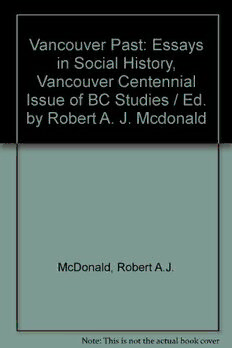
Vancouver Past: Essays on Social History PDF
Preview Vancouver Past: Essays on Social History
VANCOUVER PAST: ESSAYS IN SOCIAL HISTORY This page intentionally left blank VANCOUVER PAST: ESSAYS IN SOCIAL HISTORY Vancouver Centennial Issue of BC Studies Edited by Robert A. J. McDonald and Jean Barman University of British Columbia Press Vancouver 1986 Vancouver Past: Essays in Social History Vancouver Centennial Issue of BC Studies © The University of British Columbia Press, 1986 ALL RIGHTS RESERVED This book has been published with the help of grants from the University of British Columbia, Simon Fraser University, the University of Victoria, the Social Sciences and Humanities Research Council of Canada, the Koerner Foundation, the British Columbia Heritage Trust and the Vancouver Centennial Commission. Canadian Cataloguing in Publication Data Main entry under title: Vancouver past: essays in social history Also issued as BC studies, no. 69-70. Bibliography: p. ISBN 0-7748-0256-1 i. Vancouver (B.C.) — Social conditions. 2. Vancouver (B.C.) —History. I. McDonald, Robert A. J., 1944- II. Barman, Jean, 1939- III. BC studies. FG3847.394.V35 1986 97 i.i'33 086-091428-3 Fio89.5.v22V35 1986 ISBN 0-7748-0256-! Printed in Canada To MARGARET PRANG ON HER RETIREMENT FROM THE DEPARTMENT OF HISTORY UNIVERSITY OF BRITISH COLUMBIA Founding co-editor, BC Studies, 1968-83 Professor, Department of History, University of British Columbia, 1958-86 Head, Department of History, University of British Columbia, 1974-79 and 1982-83 President, Canadian Historical Association, 1976-77 This page intentionally left blank Contents BG STUDIES/Number 69-70 Preface 9 Cottages and Castles for Vancouver Home-Seekers DERYGK w. HOLDSWORTH 11 Working Class Vancouver, 1886-1914: Urbanism and Class in British Columbia ROBERT A. j. MC DONALD 33 Sam Kee: A Chinese Business in Early Vancouver PAUL YEE 70 Neighbourhood and Community in Interwar Vancouver: Residential Differentiation and Civic Voting Behaviour JEAN BARMAN 97 The Confinement of Women: Childbirth and Hospitalization in Vancouver, 1919-1939 VERONICA STRONG-BOAG and KATHRYN MGPHERSON 142 The Triumph of "Formalism": Elementary Schooling in Vancouver from the igsos to the ig6os NEIL SUTHERLAND 175 The Incidence of Crime in Vancouver During the Great Depression JAMES p. HUZEL 211 The Mothers' Council of Vancouver: Holding the Fort for the Unemployed, 1935-1938 IRENE HOWARD 249 "A Palace for the Public": Housing Reform and the 1946 Occupation of the Old Hotel Vancouver JILL WADE 288 A Half Century of Writing on Vancouver's History PATRICIA ROY 311 Contributors 326 Illustrations Cottage, Grand view, constructed 1892 18 Turreted house. West End, ca. 1890 18 Designs for workingmen's homes from Hodgson's pattern book 19 Half-timbered house, Third Shaughnessy, 19205 19 California bungalow, 19205 20 Stucco cottage, Point Grey, 19205 20 Printer's picnic, Gibson's Landing, ca. 1894 5° Carpenter's gathering, 1890 50 Dupont [Pender] Street, ca. 1899 51 Louis D. Taylor 51 Rev. George R. Maxwell 51 Chang Toy, founder of Sam Kee Company 80 Sam Kee Company, 433 Carrall Street, ca. 1905 80 Vancouver General Hospital, ca. 1925 149 Vancouver General Hospital, ward interior, ca. 1919 149 Lord Tennyson School, Division 3, ca. 1923 192 Cecil Rhodes School, 1949, Grade i 192 Sarah Colley 262 Helena Gutteridge 262 Mothers' Council marching in May Day Parade, George near Pender, 19305 262 Effie Jones 263 Elizabeth Kerr 263 Women's demonstration, Stanley Park, 1935 263 Old Hotel Vancouver, ca. 1927 306 Labor Progressive Party veterans picketing Old Hotel Vancouver, January 1946 306 Maps Political units and neighbourhoods, Vancouver 17 Geographical areas, Vancouver 135 CREDITS City of Vancouver Archives, 18, 50, 51, 80 top, 149 bottom, 192 top; Vancouver Public Library, 80 bottom, 262 top right and bottom, 263 top left, 306 top; Special Collections, University of British Columbia, 149 top; Pacific Advocate, 4 January 1946, 306 bottom; Sara Diamond, 263 bottom; Jane Fredeman, 192 bottom; Deryck Holdsworth, 19, 20; Patrick and Gloria Kerr, 263 top right; Louise Colley Tilton, 262 top left; Julia Sandquist, map, 17; Angus Weller, map, 135. Preface Vancouver's centennial of incorporation on 6 April 1886 has provided the impetus to this special issue of BC Studies. It seemed appropriate to bring together in a single volume research currently underway by aca- demics, graduate students and other scholars on the history of Canada's third largest city. The result has outdistanced its original, rather modest objective, the essays as a group demonstrating that the history of Vancouver is matur- ing. While previous work emphasized the city's early, formative years, the majority of essays in this volume treat the coast city as a dynamic, complex, urban place. Their concern is with the early and mid-twentieth century, thus pushing forward in time our knowledge of Vancouver's past. More importantly, perhaps, the political and economic focus of much of the previous work is here complemented by subtle and sustained analyses of Vancouver's social development. Emphasis on connections between the Burrard Inlet metropolis and its surrounding region, which as Patricia Roy points out in her essay has been a staple of writing about Vancouver, is giving way to discussion of the lives of ordinary citizens. While the essays presented here do not attempt to establish a single interpretation of west coast life, together they touch on many aspects of the Vancouver experience, enriching our understanding of the city's history and opening numerous topics for further discussion. Deryck Holds- worth and Jean Barman explore the social significance of spatial arrange- ments. Holdsworth argues that, to 1929 at least, this low density, subur- ban city more readily fulfilled people's aspirations to live in detached houses than did the industrial centres of eastern Canada and Great Britain from which most residents came; Barman documents the social character of Vancouver neighbourhoods, concluding that, during the interwar years, the socio-economic distinctions separating East Side from West Side were lessened by the integrating ties of community. In an overview of working class life to 1914, Robert McDonald argues that, while capitalist economic relations fundamentally divided Vancouver's 9 BG STUDIES, nos. 69-70, Spring-Summer 1986
